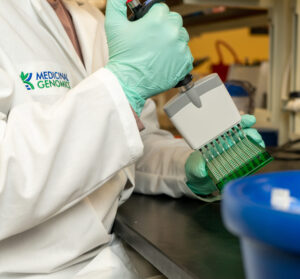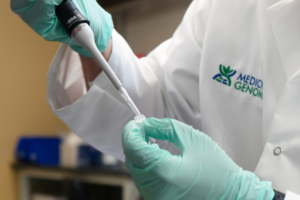The lack of consistent testing regulations contributes to a host of problems for the cannabis industry, including, but not limited to, the release of harmful products for patients & consumers, crop loss for growers, and even legal troubles for themselves.
For the past few years, we at Medicinal Genomics have compiled and continuously updated a compendium of microbial testing regulations in cannabis legal states. The latest results show that the current collection of inconsistent regulations—and in some cases, no regulations at all—isn’t good for anyone. Not the consuming public. Not the growers. Not even the regulators themselves. Many regulators are put in the impossible position of trying to balance the needs of their constituents against the scientific evidence that cannabis requires more rigorous testing regimens than the industry, in many cases, is unwilling to accept, but which are required to protect consumers.
For example, growers in Oregon registered their displeasure last year by lodging protests—and eventually lawsuits—against the state’s regulators for trying to institute testing for the four pathogenic Aspergillus molds. These tests are mandated and performed without incident in 23 other states and 1 US Territory. Their pressure campaign initially got the state’s regulatory board to postpone testing implementation, and then in a surprise ruling late last summer, to scrap the offending regulations altogether, which is a decision that will put cannabis consumers, especially the immunocompromised, at risk.
All the differences make a difference.
Our analysis shows as of December 2023, medical cannabis is legal in 38 States, 4 US territories, & the District of Columbia, and adult use is legal in 24 States, 2 US territories, & the D.C. Of those, thirty-eight (38) states, 2 US territories, and the D.C. have microbial testing regulations. But the number of required microbial tests ranges from 1 to 10 per jurisdiction. Furthermore, action levels for “total count” tests differ by several ORDERS OF MAGNITUDE from state to state or territory.
This variance is significant because many states’ safety testing guidelines rely on broad microbial tests, such as TYM (Total Yeast and Mold) borrowed from other industries (e.g., food processing). The problems with this approach are few but important:
- Products Fail for the Wrong Reason: “Total” count tests do not differentiate between beneficial microbes, which many cultivators use to control a variety of pests and pathogens that are dangerous to human health. The biological pesticides are predominately molds and Gram-positive bacteria. This confusion and misidentification cause false positive results that fail millions of dollars worth of product needlessly.
- Illusion of Safety: Total count tests give the illusion of efficacy, because they purport to enumerate everything. In fact, multiple studies discuss the challenges of culturing microbial species. One study states that we can cultivate roughly one out of every 100 microbes. This is what has been described as “The Great Plate Count Anomaly” (https://onlinelibrary.wiley.com/doi/abs/10.1128/9781555819606.ch71)
- Unforeseen Consequences of Non-Species Specific Regulations: Total Aerobic Microbial count will not differentiate between Gram-negative and Gram-positive bacteria. Gram-negative bacteria are the source of endotoxins when a batch is remediated (https://osf.io/preprints/osf/gdqbx). Endotoxins are lipopolysaccharides found in the cell wall of Gram-negative bacteria, which can induce inflammation and fever as an immune response in humans. Reaction to endotoxins can lead to anaphylactic shock and death of patients. Without genus species-specific tests, counting the members of a microbial population in no way accurately indicates the presence of dangerous pathogens. In addition, many growers turn to the use of chemicals to reduce the bioburden of failing batches. Over 40% of cannabis recalls are related to pesticides including Myclobutanil, which represented 22% of all pesticide recalls. Myclobutanil is converted into hydrogen cyanide when smoked or vaporized.
The number of recalls over the last seven years bears witness to the chaotic state of the industry. We were able to identify two-hundred twenty cannabis product recalls from information provided from twenty state cannabis regulatory agencies, while nine recalls from five states were identified from news agency investigative reports. Four states accounted for >70% of the recalls. Colorado issued 89 recalls (39%), Washington had 33 recalls (14%), Michigan had 25 recalls (11%), and Oregon 21 recalls (9%).
Sixty-five recalls (28%) were due to one or more microbial test failures. The microbial tests that caused the most recalls were Total Yeast and Mold count (45%) and one of the four Aspergillus (39%). These Aspergillus human pathogens can cause illnesses of the respiratory and gastrointestinal tracts, or even death, in immunocompromised individuals.
Test failures for the presence of pesticides were no better. These chemicals are used in agriculture to control pests and support higher crop yields. Applied prior to or during the growing process and/or post-harvest, pesticide residues on cannabis products pose a health risk. In addition, consumption of pesticides may confer substantial sequelae, including malignancy, and developmental, reproductive, neurological, & endocrine disorders. Ninety-two (40%) recalls were due to residues of one or more pesticides. The pesticides that caused the most recalls were Myclobutanil (22.3%), Imidacloprid (8.3%), and Avermectin (7.4%), all of which are dangerous to humans.
Heavy metals, such as cadmium and lead, were also found in failed samples and accounted for twelve recalls (5%).
The need is obvious, and the time is now.
In light of the “will-they-won’t-they-when-will-they” drama around cannabis rescheduling, many state regulators may feel there is no point in reconsidering their regulations if the federal government is simply going to override their authority anyway. While this stance is certainly understandable, it ignores two very important reasons why every state has a responsibility to do just that. First, there is no timetable for rescheduling and the ability of the DEA to postpone a decision indefinitely should not be underestimated. Meanwhile, cannabis is being consumed at a record pace, increasingly used as medicine, and consumers are unnecessarily being put at risk by regulations that are inappropriate, inaccurate, or both. Second, whenever rescheduling does happen, the federal government will (hopefully) not reinvent the wheel when it comes to testing; they will look to the most successful state programs as a template for consistent nationwide testing.
This past year since 2016, Colorado experienced a record number of recalls associated with contamination — especially for pathogenic Aspergillus species, molds that can cause serious harm, particularly with immunocompromised users. CDC case reports identified invasive fungal diseases in persons who use cannabis contaminated with fungal strains, and fungal contamination. In a large health insurance claims database, persons who used cannabis were 3.5 times more likely than persons who did not use cannabis to have a fungal infection in 2016. (https://wwwnc.cdc.gov/eid/article/26/6/19-1570_article) Moreover each year, over 6.5 million persons contract life-threatening fungal infections with 2.5 million attributable deaths. The annual global incidence of invasive aspergillosis was estimated at >2 million with a mortality of 1.8 million. https://www.jwatch.org/na57045/2024/02/01/worldwide-burden-fungal-infections
These findings caused regulatory agencies to call for stricter observance of the rules. But just recently, an industry group lobbied Colorado lawmakers to put forth a bill that would eliminate the Aspergillus pathogen testing altogether. This reaction is completely understandable, seeing as how growers in Oregon got their regulatory agency to back down, but this is nothing more than another cynical attempt on the part of growers to balance their books in exchange for users’ health. This is also understandable, considering that Colorado’s cannabis industry has had a rough couple of years economically, but legislation like this puts the operation of the proverbial henhouse firmly in the paws of the foxes.
The more jurisdictions that modify and adopt sensible, accurate microbial testing rules, the faster the industry will adapt and produce safer products. This is not to imply the task will be simple: although flower test combinations are extremely diverse (>60% of the jurisdictions have unique microbial test combinations), a national survey of flower microbiomes will identify additional pathogens of concern and hopefully a more unified consensus set of pathogens will emerge. Our firm analyzed 1,509 cannabis microbiomes in our Kannapedia.net database. The microbiomes analysis included reviewing sequencing data from flower, root, leaf, stem and seeds of the plant. The two tables below contain a list of the top 21 genera of fungi and bacteria found on cannabis samples from across the United States.


The US Health & Human Services (HHS) understands this and said as much in a recent article in Cannabis Business Times that described the HHS’s unredacted recommendation that cannabis be rescheduled:
“HHS also lamented the lack of uniformity among state-level cannabis regulations and the total lack of regulation of the illicit market, describing it as a “safety” and “quality” problem.39 Considered alongside the agency’s emphasis in Part 1 of CAMU test on the importance of longstanding and widespread experience regulating and using medical cannabis in treatment among state regulators and HCPs, respectively, I began to sense a theme running through HHS’s analysis. Perhaps the agency hopes its exhaustive analysis will nudge state lawmakers and regulators to take coordinated action to bring greater uniformity to the safety controls and regulatory requirements applicable to medical cannabis under state law.”
But this is merely the first step of many towards a safer cannabis supply chain. To that end, we also support the FDA’s and CDC’s positions to modernize the regulatory framework, while leveraging the use of proven molecular tools to accelerate predictive capabilities, prevention, speed outbreak response, and enhance our ability to swiftly adapt to crises that could impact consumer safety. However, one critical but misguided component in the FDA’s Blueprint for a Safer Food System is the appeal to antiquity by requiring all methods to be compared to culture-based techniques. It is far past time to retire this time-worn technology and we urge the regulators to modernize the historical reference standard to whole genome sequencing and allow all methods to be compared to the most sensitive and specific technology available today.
For cannabis to be regarded seriously as medicine, and as a cultural phenomenon consumed for pleasure by millions worldwide, it must be deemed unquestionably safe. To achieve that standard, cannabis testing must not be blindly applied from other industries, but rather must be met with the best possible science available to powerfully advance our understanding of cannabis’ many unique properties and to accurately and positively identify the specific human pathogens it can host. Only then will we arrive at a consistent, coherent, and comprehensive set of regulations everyone can live with.
Recalls and Regulations: supporting illustrations and figures
1. Analysis of list of recalls
Analyzing the list of recalls offers crucial insights into product safety and quality. By identifying patterns and reasons for recalls, companies can enhance preventive measures and manufacturing processes, ultimately improving overall product reliability and consumer safety.
Among the 229 recalls, CO has the highest number of recall reports with 89, followed by WA with 33, MI with 25, and OR with 21 recall reports. OH and AZ have 12 each, NV has 9, CA has 6, OK has 4, MO has 3, and MA, AK, FL, and NY each have 2 recall reports. Additionally, Canada, VT, MD, NJ, ME, IL, and NM each have 1 recall.

For the annual analysis of the four states with the highest recall reports, CO led in recalls in 6 of the 8 years. WA and MI had their highest recalls in 2019. OR had their highest recalls in 2023.

2. Recall classification
There are various reasons reported for cannabis product recalls, encompassing issues related to testing and laboratory testing noncompliance to ensure product safety. Additionally, reasons include packaging defects and non-compliance with tracking systems. However, it’s worth noting that some recall reports do not clearly specify the reason for the recall. Greater clarity is required in the recall list, specifically in detailing the reasons for each recall.
# | Reason for Recall | Count of Reason for Recall | % Reason for Recall |
1 | Contamination, pesticide | 92 | 40.17 |
2 | Contamination, microbial | 65 | 28.38 |
3 | Testing, improper | 24 | 10.48 |
4 | Contamination, metal | 12 | 5.24 |
5 | Labeling, improper | 10 | 4.37 |
6 | Additives, prohibited | 9 | 3.93 |
7 | Manufacturing, defect | 4 | 1.75 |
8 | Adverse Health Events | 4 | 1.75 |
9 | Packaging, defect | 3 | 1.31 |
10 | Tracking System, non-compliance | 2 | 0.87 |
11 | Cannabinoid, non-compliance | 3 | 1.31 |
12 | Handling and storage, compliance | 1 | 0.44 |
13 | Product, prohibited | 1 | 0.44 |
14 | Contamination, foreign matter | 1 | 0.44 |
15 | Contaminant, human saliva | 1 | 0.44 |
16 | Contaminant, solvent | 1 | 0.44 |
17 | Contaminant, mycotoxins | 1 | 0.44 |
18 | Manufacturing, non-compliance | 1 | 0.44 |
| Grand Total | 229 | 100 |

We have analyzed the various reasons for recalls for the 5 contaminant types. Many recalls were due to a contaminant test result that exceeded the action limit.
Pesticides – Forty percent (40%) – 92 of 229 recalls were due to a pesticide test failure. 23 pesticides were identified. Most prevalent were Myclobutanil (22.3% of pesticide recalls), Imidacloprid (8.3%), and Avermectin (7.4%). In 30.6% of the recalls, the specific pesticide was not identified
| # | Pesticide, Salt, or Pesticide Not Identified | # of Recalls | Percentage of All Recalls (229) | Percentage of Pesticide Recalls (121) |
| 1 | Myclobutanil | 27 | 11.79 | 22.31 |
| 2 | Imidacloprid | 10 | 4.37 | 8.26 |
| 3 | Avermectin | 9 | 3.93 | 7.44 |
| 4 | Etoxazole | 5 | 2.18 | 4.13 |
| 5 | Spinosyn | 4 | 1.75 | 3.31 |
| 6 | Spiromesifen | 3 | 1.31 | 2.48 |
| 7 | Abamectin | 2 | 0.87 | 1.65 |
| 8 | Bifenazate | 2 | 0.87 | 1.65 |
| 9 | Bifenthrin | 2 | 0.87 | 1.65 |
| 10 | Diuron | 2 | 0.87 | 1.65 |
| 11 | Ethephon | 2 | 0.87 | 1.65 |
| 12 | Paclobutrazol | 2 | 0.87 | 1.65 |
| 13 | Pyrethrins | 2 | 0.87 | 1.65 |
| 14 | Pyrimethanil | 2 | 0.87 | 1.65 |
| 15 | Tebuconazole | 2 | 0.87 | 1.65 |
| 16 | Azoxystrobin | 1 | 0.44 | 0.83 |
| 17 | Chlorfenapyr | 1 | 0.44 | 0.83 |
| 18 | Chlorpyrifos | 1 | 0.44 | 0.83 |
| 19 | Malathion | 1 | 0.44 | 0.83 |
| 20 | Permethrin | 1 | 0.44 | 0.83 |
| 21 | Piperonyl butoxide (PBO) | 1 | 0.44 | 0.83 |
| 22 | Propiconazole | 1 | 0.44 | 0.83 |
| 23 | Pyriproxyfen | 1 | 0.44 | 0.83 |
| 24 | Not provided | 37 | 16.16 | 30.58 |
| Grand total | 121 | 52.84 | 100 |
The pesticides in the red font above are chemical derivatives of azoles. Since the class of medications that are used for aspergillosis are from the azole derivatives, the use of azole pesticides may be causing the appearance of Aspergillus pathogens that are resistant to azoles.
Microbials – Twenty-eight percent (28%) – 65 of 229 recalls were due to a microbial test failure. Six microbial tests were identified. Most prevalent were Total Yeast and Mold (52.5% of Microbial Testing recalls), and one of the pathogenic Aspergillus species (40.0%).
# | Microbial Test Failure | # of Times a Microbial Test Failed | Percentage of Recalls |
1 | Total Yeast and Mold | 42 | 52.5 |
2 | Aspergillus flavus, Aspergillus fumigatus, Aspergillus niger, Aspergillus terreus | 32 | 40 |
3 | Salmonella species | 2 | 2.5 |
4 | Total Viable Aerobic Bacteria | 2 | 2.5 |
5 | Total Coliforms | 1 | 1.25 |
6 | Total Aerobic Microbial | 1 | 1.25 |
| Grand Total | 80 | 100 |
- The number of recalls that had >1 failed microbial tests was 15.

Metals – 12 of 229 recalls (5.2%) were due to a metal test failure. 5 Metals were identified. Most prevalent were Cadmium and Lead (25% of metal recalls each) with 8.33% Not provided
| # | Metal Test Failure | # of Recalls | Percentage of Recalls |
| 1 | Cadmium | 3 | 25.00 |
| 2 | Lead | 3 | 25.00 |
| 3 | Arsenic | 2 | 16.67 |
| 4 | Mercury | 2 | 16.67 |
| 5 | Nickel | 1 | 8.33 |
| 6 | Not provided | 1 | 8.33 |
| Grand Total | 12 | 100 |

Solvent/Mycotoxin – There is one recall (0.44%) each for Solvent and Mycotoxin.
Solvent, residual | Ethanol |
Mycotoxins, contamination | Mycotoxins, not designated |
3. Total Recalls
Among a total of 229 recalls, 2023 stands out with the highest number at 64, followed by 2021 (34), 2022 (32), 2016 (33), 2019 (31), 2020 (18), 2017 (11), 2018 (5), and 2015 (1). The reason for the lowest number of recalled products in 2015 is presumed that obtaining information about recalls becomes more challenging as the years go back in time.

The complete dataset on this study will be presented in greater detail at the CannMed 24 Innovation and Investment Summit, Marco Island, FL, May 12-15th by Dr. Sherman Hom.
Dr. Sherman Hom is the Director of Regulatory Affairs for Medicinal Genomics, Inc. Prior to joining MGC, Dr. Hom was a Research Scientist in New Jersey’s Department of Health Division of Public Health and Environmental Laboratories (PHEL), where, as a Project Manager, he coordinated all PHEL’s pre-analytical activities supporting its SARS-CoV-2 testing. Prior to that, he was the Project Manager for starting the state’s Cannabis Testing Lab and subsequently for validating Microbial Testing of Cannabis products. He has also been a professor of microbiology, a laboratory manager, a senior research scientist, a writer, and an inventor. He was a Postdoctoral Fellow in Molecular Genetics at The Johns Hopkins University, holds a Ph.D. in Microbiology from the University of California at Davis, and a B.A. in Biology from UC San Diego.
By Sherman Hom, Ph.D.
Director of Regulatory Affairs
Medicinal Genomics Corp.
Jaime Troth
Graphics by Hyunji Ha M.S., Medicinal Genomics Regulatory Research Team
Data source:








